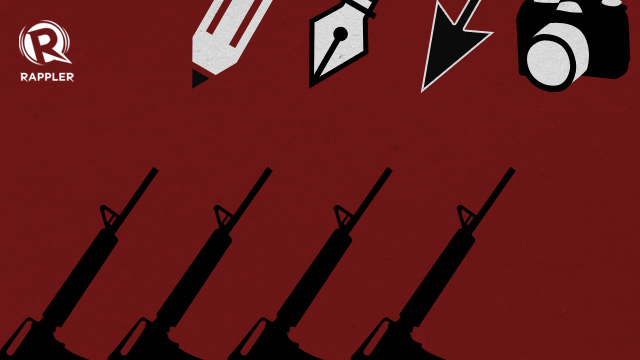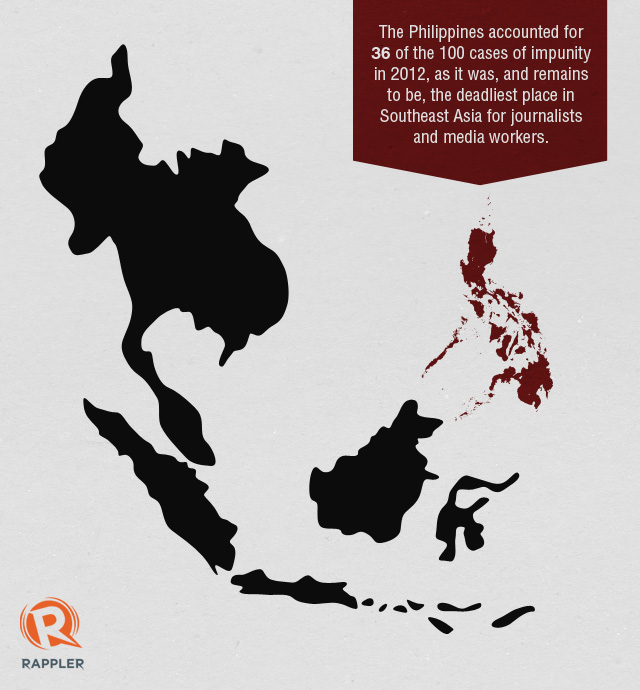SUMMARY
This is AI generated summarization, which may have errors. For context, always refer to the full article.

MANILA, Philippines – At least a hundred cases related to impunity against the exercise of freedom of expression have been recorded in Southeast Asia for 2012, according to the Southeast Asian Press Alliance (SEAPA), a regional network of independent, national media organizations.
Of 10 countries covered in the alerts and monitoring network of SEAPA, the Philippines landed first on the list – as it was, and remains to be, the deadliest place in Southeast Asia for journalists and media workers.
The Philippines accounted for a full third or 36 of the 100 cases of impunity that SEAPA has recorded in the first 10 months of 2012 alone.
These 36 cases included nine murders, 17 cases of threats, and 10 cases of attacks.
All the cases recorded in the Philippines involved “impunity through violence” mostly against journalists, and two activists (including one witness to a media murder case).
SEAPA logged 13 killings in all in 2012. The Philippines accounted for two-thirds or nine cases.
On Tuesday, November 20, SEAPA released a brief “report of its count of impunity-related incidents in 2012,” as it began a series of activities to mark the International Day to End Impunity (IDEI) on Friday, November 23 that is also the third anniversary of the Maguindanao Massacre.
According to SEAPA executive director Gayathry Venkiteswaran, the numbers mean that there is a lot of work to do in the region to end the culture of impunity.
“SEAPA looks not only at acts of violence, but also legal action of states to suppress the right of freedom of opinion and expression,” she said, noting that of the 100 cases, 29 were committed by state parties in the name of the law.
Of the 100 cases, SEAPA said 71 involved cases of “impunity through violence,” including 35 cases of threats, 23 cases of attacks, and 13 murder cases, mostly involving journalists.
The balance of 29 cases involved “impunity by law,” including 22 cases of criminal prosecution, and seven cases of arrest and detention of journalists.
“Southeast Asia remains problematic with regards to safety and protection of journalists with 100 impunity-related cases recorded, or 71 cases of violent incidents (including threats) both from state and non-state actors, and 29 cases of state legal actions,” SEAPA said.
Escaping punishment
According to SEAPA, the culture of impunity in the region has two faces: the first is that perpetrators of violence are able to escape punishment for their crimes. Without fear of consequences, perpetrators continue to carry out such acts.
The second, SEAPA said, is that states also commit impunity by prosecuting acts of freedom of expression. This not only creates a climate of fear among citizens and journalists, but also emboldens some groups to attack those who express critical messages.
Impunity, SEAPA said, can be broadly defined as non-accountability for actions that violate rights.
“This means individual perpetrators escape or are exempt from punishment or prosecution, perhaps due to the absence of rule of law.
Because of this, more such acts will be committed because it is highly unlikely that perpetrators will be made to answer for their crimes,” SEAPA said.
“On a bigger level, impunity also concerns states that can continually mete out punishment without accountability on human rights concerns.”
SEAPA counted the 100 cases through its media monitoring and Alerts system, which publicizes acts of violations of the right to freedom of expression in Southeast Asia.
Under the category of “impunity through violence,” SEAPA reported:
– Attacks or “acts to inflict physical harm against a person, sometimes with the intent to kill,” include attacks against organizations, both physical and cyber attacks.
Across the 10 countries, by category of cases, SEAPA’s report said:
– Of the 23 cases of attacks, 21 relate to journalists, including two that are not work-related. Ten cases of attacks come from the Philippines, and 5 from Indonesia. The Aliansi Jurnalis Independen (AJI) has said, however, that as of the end of May they have received reports of 20 cases of violence.
– Threats or harassment refer to “cases of warnings against journalistic or free expression actions; includes both threats to commit physical and legal action against the victims.” Thirty-one of the 35 incidents relate to journalists; one case each relate to blogs, a media official, a concert, and an NGO. The Philippines has 17 cases, with almost all but one directed at individual reporters.
– Killings of or involving journalists and civil society activists. Thirteen cases reported in 2012, including 11 journalists and two activists. Nine killings were recorded in the Philippines, including one activist and one witness to a murder case witness. At least three are work-related murders.
Under the category of “impunity by law,” across the 10 nations covered in the report, SEAPA said:
– Detention and imprisonment or cases of arrest or detention for journalistic work or acts of free expression, whether with charges or not. This category does not include detention cases that resulted in convictions. Only 2 of 8 arrest incidents involve journalists. Two are related to bloggers. Half of the cases were reported in Vietnam.
– Criminalization of expression or the filing of criminal charges and conviction against journalistic work or free expression activities. This category includes the sentencing of detentions before 2012. Eight of the 21 cases involve journalists or news agencies. Of the 21 cases, 18 were initiated by the state or specific state agencies.
Vietnam is the country with the most cases, accounting for a third of the total. Cambodia and Burma follow with 5 and 4 cases, respectively.
Thirteen cases involved convictions for criminal charges.
SEAPA noted that “violent incidents recorded were directed at journalists, while more legal actions were pointed towards individual acts of free speech.”
A similar pattern can be observed in countries with relatively freer media environments, such as Indonesia and the Philippines, where more acts of violence against journalists were recorded.
Meanwhile, SEAPA said there were more government initiatives to suppress free expression recorded in Vietnam and Burma/Myanmar, which have restricted media environments.
OBSERVATIONS BY COUNTRY
Burma/Myanmar:12 incidents
Most cases involve state interventions in the private media, concerning reporting on sensitive issues, such as government corruption, the military and ethnic unrest. No incidents of violence were reported except for cyber attacks (DDOS) against erstwhile exile media. Only one case involved a specific journalist—a DVB reporter who was accused by a government official for disturbance and tresspassing.
Cambodia: 12 cases
5 of the 12 cases involve civil society. This is restriction of civil society is somehow connected to moves to impose stricter control with the widely-criticized draft NGO law. 6 cases are concerned with politics, while four cases concern local issues (land and logging).
Indonesia: 10 cases
9 of 10 cases are related to violence (attacks, killings and threats).
3 cases involved the military personnel’s heavy handed responses to journalistic activities; 2 cases concern religion
Laos: 1 case
The only case from Laos concerns the unlawful closure of a radio program, which was based on minister’s verbal order to the radio station director.
Malaysia: 9 cases
Four cases in Malaysia relate to the response of authorities to journalistic coverage of issues. Of these, only one case is from a private complaints.

Philippines: 36 cases
The Philippines is the most dangerous place to be a journalist in Southeast Asia, accounting for more than half of the violent incidents against journalists. Notably, there are no recorded cases of arrests or prosecution against journalists.
Almost all of the cases (except one or at most two) concern local issues.
Singapore: 1 case
This relates to the conviction of a person linked with an online post, which the court deemed as inciting to violence.
Thailand: 4 cases
Two of Thailand’s cases relate to the controversial lese majeste law.Timor Leste’s only recorded case is about the mauling of a radio announcer who had reported on a corruption case.
Timor-Leste: 1 case of attack
Vietnam: 17 cases
7 of 11 cases of impunity by law from Vietnam are related to bloggers, including 3 cases of convictions of bloggers (5 persons). Also, 7 of these cases relate to charges of conducting anti-state propaganda (Article 88 of the penal code). Only two cases relate to journalists, including only one of an active journalist concerning an investigative report. – PCIJ
Add a comment
How does this make you feel?
There are no comments yet. Add your comment to start the conversation.